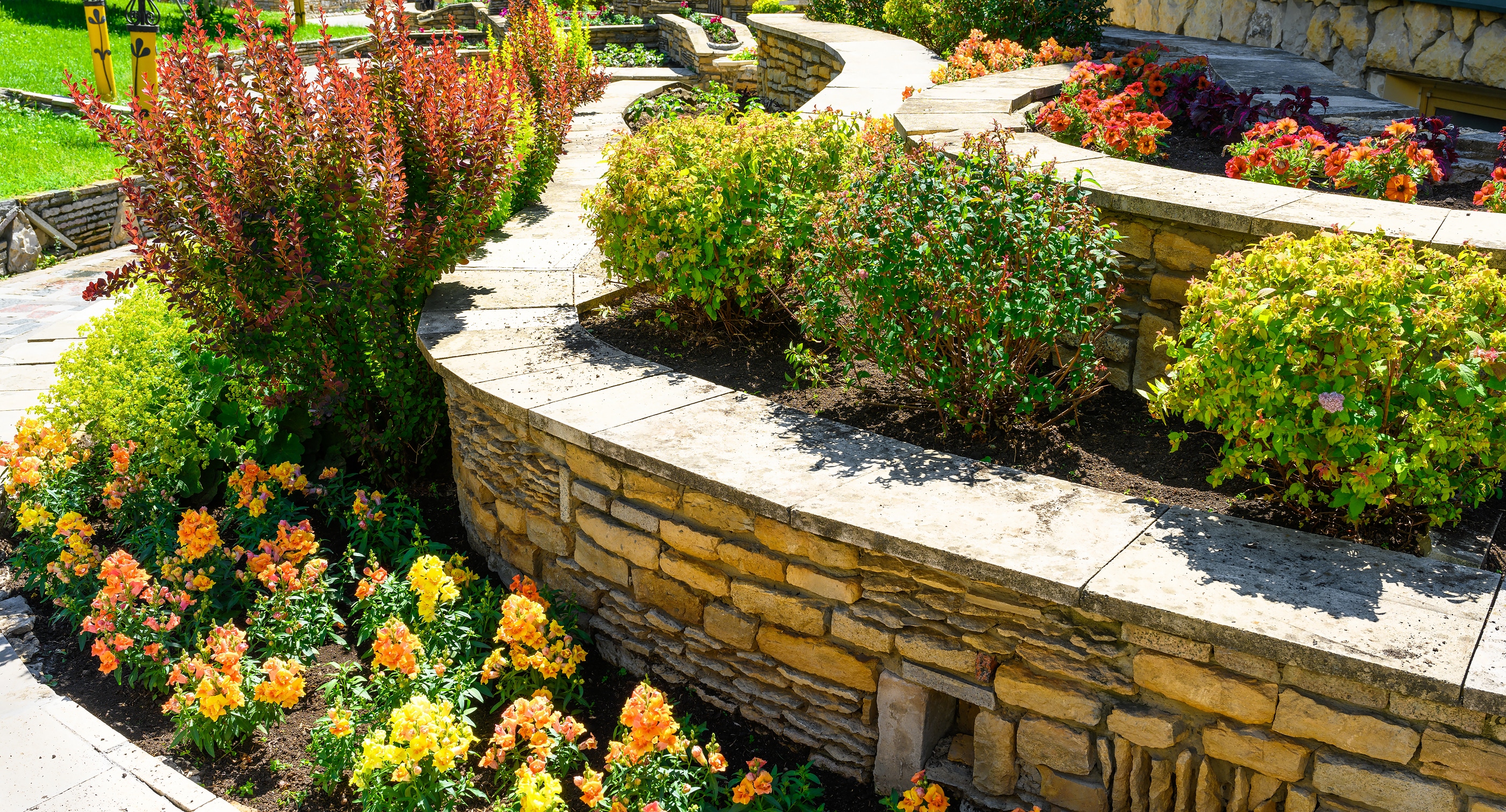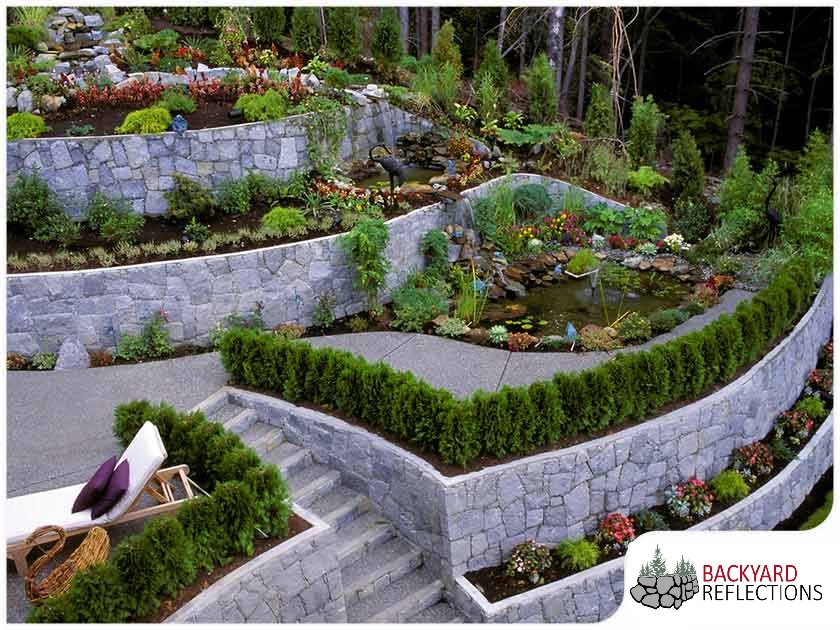The best materials for building long-lasting OKC Precision Retaining Walls
The best materials for building long-lasting OKC Precision Retaining Walls
Blog Article
Key Factors To Consider for Building Effective Retaining Walls in Your Backyard
When you're taking into consideration constructing a keeping wall in your backyard, it's crucial to consider a number of essential factors. The wall surface's objective, the products you'll utilize, and the specific dirt problems can all influence its efficiency and longevity. You'll also require to navigate neighborhood structure codes and prepare for proper drainage. Exactly how do you assure your style not just meets these demands yet likewise boosts your landscape? Let's discover the crucial actions with each other.
Understanding the Function of Your Retaining Wall
When you consider developing a preserving wall, consider its main function: maintaining dirt and avoiding disintegration. Retaining walls provide necessary assistance for sloped landscapes, helping to preserve dirt integrity. You'll discover they're vital in areas where water drainage might otherwise clean away soil, causing costly repair services and landscape damages.
By holding back planet, these walls create degree surface areas for gardens, patio areas, or pathways. This not just enhances your lawn's looks but likewise advertises far better drainage, decreasing water pooling in unwanted locations. If you're taking care of high inclines, a well-constructed retaining wall can stop landslides, making certain safety for you and your building.
Ultimately, understanding the purpose of your retaining wall surface will certainly guide your design decisions and help you develop a useful, durable framework that satisfies your demands. Take a minute to evaluate your landscape; it'll pay off in the long run.
Choosing the Right Materials
When selecting products for your retaining wall, you'll wish to think about resilience, aesthetics, and price. Each factor plays a vital function in ensuring your wall stands the examination of time while looking excellent and fitting your budget. Allow's check out exactly how to make the very best selections for your project.
Material Longevity Aspects
Picking the ideal products is crucial for the longevity and performance of your retaining wall, since their longevity directly influences the wall's capacity to stand up to environmental stresses. Begin by considering your local climate; products like concrete and stone stand up to moisture and temperature level fluctuations well. If you reside in an area susceptible to hefty rains, go with materials with great drainage residential or commercial properties, like crushed rock or porous blocks, to stop water buildup.
Some materials do better in certain dirt types, so it's crucial to match them as necessary. Selecting long lasting products warranties your retaining wall stands strong, safeguarding your lawn for years to come.
Visual Layout Selections
Long lasting materials not just ensure your retaining wall's architectural integrity but likewise play an essential duty in its aesthetic appeal. Do not fail to remember about the wall surface's shape-- bent walls can create a softer look, while straight lines can feel extra organized. By carefully picking products that align with your visual vision, you'll enhance your exterior space while guaranteeing your wall stands solid against the aspects.
Cost-Effectiveness Analysis
Selecting the ideal products for your retaining wall surface isn't simply about aesthetic appeals; it's additionally essential for your budget. When selecting materials, think about both ahead of time prices and long-lasting sturdiness.
Don't fail to remember to element in maintenance costs also (OKC Precision Retaining Walls). Some materials, like all-natural stone, can include appeal and need much less maintenance, while others might require routine therapies
Eventually, evaluate the pros and cons of each choice versus your spending plan and the wall surface's intended objective. Investing carefully in materials now can stop expensive problems down the road. Select materials that balance cost and efficiency efficiently.
Evaluating Soil Problems and Water Drainage
As you begin your project, reviewing dirt conditions and water drainage is vital for the success of your retaining wall. Sandy dirt drains well yet lacks security, while clay soil can preserve wetness, leading to pressure on your wall surface.
Next, analyze the slope of your backyard. If water naturally moves toward your wall surface, you'll need to apply a drain solution to stop erosion and stress build-up. Take into consideration setting up perforated pipelines or gravel backfill behind the wall surface to help with water drainage.
Lastly, observe any kind of nearby trees or plants; their roots can affect soil stability. By recognizing your dirt conditions and applying proper drain, you'll produce a strong foundation for your retaining wall surface that stands the examination of time.
Adhering To Local Building Regulations
Before you begin building your retaining wall, you require to study local policies to ensure conformity. It's important to recognize what allows you must acquire, as this can conserve you from pricey fines or having to redesign your job. Taking these steps seriously will help you build a safe and efficient structure.
Research Study Local Rules
Recognizing regional laws is necessary when planning your retaining wall surface job, specifically given that developing codes can differ considerably by area. Look for guidelines on wall surface height, products, drainage systems, and architectural integrity. By doing your research study upfront, you can assure your retaining wall fulfills all necessary codes and blends seamlessly into your yard.
Acquire Necessary Licenses
As soon as you've investigated neighborhood policies, the following action is to obtain the required permits for your retaining wall surface task. This procedure assurances your wall surface abides by building regulations and security criteria. Reach out to your local structure authority to locate out what permits you need. They might call for specific plans or design analyses, especially for larger walls. Be prepared to submit comprehensive illustrations, consisting of measurements and materials. Do not neglect to examine if your project impacts water drainage or bordering properties, as these elements may need extra authorizations. Protecting the ideal authorizations can conserve you from pricey penalties or needing to dismantle your wall surface later on. Bear in mind, following the rules now will result in a smoother building experience.

Planning the Design and Aesthetic Appeal
As you commence intending the layout and looks of your retaining wall surface, think about how it will certainly balance with the surrounding landscape. Think of the materials you'll make use of-- stone, block, or concrete-- and exactly how they'll complement your home's style and the natural environments in your backyard. Select colors and appearances that blend flawlessly with existing functions like patios, paths, or gardens.
Next, envision the wall surface's shape and elevation. Rounded walls can soften a rigid landscape, while straight lines may share an extra contemporary appearance. Don't neglect to integrate plants and greenery around the wall surface for a natural touch; this can improve its appeal and incorporate it into the atmosphere.
Lastly, keep in mind performance. Your style needs to not only be aesthetically pleasing but likewise offer its purpose effectively. By thoughtfully intending these elements, you'll produce a preserving wall that improves your backyard's beauty while satisfying its architectural function.
Computing Height and Thickness Demands
To construct a sturdy visit this page retaining wall, you require to accurately compute its height and thickness demands based upon the dirt conditions and the height of the slope it will sustain. Beginning by evaluating the slope's angle and the sort of dirt, as various dirts apply differing quantities of pressure.
For walls over four feet high, think about a density of at the very least 12 inches. If the wall surface is taller, increase the thickness proportionally to maintain stability.
Next, determine the elevation of the wall surface by measuring the vertical distance it needs to keep. For each foot of elevation, you need to commonly prepare for a density of one-third of the wall surface's elevation.
Constantly bear in mind to make up added variables like water drainage and backfill, which can affect your wall surface's design. Correct computations currently assure your retaining wall surface stands strong and lasts for several years to find.
Upkeep and Longevity Considerations
While keeping your retaining wall surface may seem like a low priority, overlooking it can cause significant concerns with time. Normal examinations are crucial; look for fractures, bulges, or any indicators of water damages. Attending to these issues early can save you from pricey repair services in the future.
Watch on drainage systems, also. Blocked drains can create water to develop, putting in stress on your wall surface and compromising its security. Clear particles and assurance proper circulation to preserve longevity.
You may additionally want to reflect on sealing your wall surface to safeguard it from moisture and weathering. Depending upon the material, this might require reapplication every few years.
Lastly, landscape design around your wall can sustain its honesty. Stay clear of planting large trees close by, as their roots can undermine the foundation. With positive maintenance, your retaining wall can offer you well for many years to come.

Frequently Asked Concerns
Can I Build a Retaining Wall by Myself, or Should I Employ a Specialist?
You can absolutely build a preserving wall yourself if you have the right devices and expertise. Hiring an expert warranties it's done correctly, especially for larger or more intricate structures. Consider your ability level prior to determining.
What Are one of the most Usual Blunders Made When Building Retaining Walls?
When building retaining walls, you may overlook appropriate water drainage, avoid making use of the appropriate materials, or forget support. These common mistakes can lead to structural failing, so take your time and strategy meticulously to stay clear of concerns.
Just how Do I Know if My Retaining Wall Needs Support?
You'll know your retaining wall index surface requires support if you see splits, leaning, or protruding. Look for water pooling behind it or soil erosion near the base. Address these signs promptly to avoid additional damage.
What Plant kingdom Are Suitable for Landscaping Around a Retaining Wall?
When landscape design around a maintaining wall surface, take into consideration making use of low-maintenance plants like succulents, decorative grasses, or creeping ground covers - OKC Precision Retaining Walls. They'll grow in those visit the site problems and include appeal while stopping dirt disintegration around your wall surface
Just How Can I Stop Erosion Around My Retaining Wall?
To stop erosion around your retaining wall surface, you can plant ground cover, usage compost, and set up drain systems. Regularly check for water build-up and change landscaping to redirect runoff far from the wall surface.
Report this page